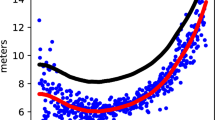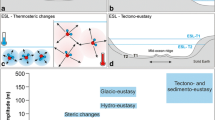Abstract
Data from the World Wide Lightning Location Network (WWLLN) for the period 2005–2011 and data composite of the Lightning Imaging Sensor/Optical Transient Detector (LIS/OTD) for 1995–2010 are used to analyze the lightning activity and its diurnal variation over land and ocean of the globe. The Congo basin shows a peak mean annual flash density of 160.7 fl km−2 yr−1 according to the LIS/OTD. The annual mean land to ocean flash ratio is 9.6:1, which confirms the result from Christian et al. in 2003 based on only 5-yr OTD data. The lightning density detected by the WWLLN is in general one order of magnitude lower than that of the LIS/OTD. The diurnal cycle of the lightning activity over land shows a single peak, with the maximum activity occurring around 1400-1900 LT (Local Time) and a minimum in the morning from both datasets. The oceanic diurnal variation has two peaks: the early morning peak between 0100 and 0300 LT and the afternoon peak with a stronger intensity between 1100 and 1400 LT over the Pacific Ocean, as revealed from the WWLLN dataset; whereas the diurnal variation over ocean in the LIS/OTD dataset shows a large fluctuation.
Similar content being viewed by others
References
Abarca, S. F., K. L. Corbosiero, and T. J. Galarneau Jr., 2010: An evaluation of the Worldwide Lightning Location Network (WWLLN) using the National Lightning Detection Network (NLDN) as ground truth. J. Geophys. Res., 115, D18206, doi: 10.1029/2009JD013411.
Beirle, S., H. Huntrieser, and T. Wagner, 2010: Direct satellite observation of lightning-produced NOx. Atmos. Chem. Phys., 10(22), 10965–10986.
Boccippio, D. J., S. J. Goodman, and S. Heckman, 2000: Regional differences in tropical lightning distributions. J. Appl. Meteor., 39(12), 2231–2248.
Bourscheidt, V., O. P. Junior, K. P. Naccarato, et al., 2009: The influence of topography on the cloud-toground lightning density in South Brazil. Atmos. Res., 91(3–4), 508–513.
Christian, H. J., R. J. Blakeslee, D. J. Boccippio, et al., 2003: Global frequency and distribution of lightning as observed from space by the Optical Transient Detector. J. Geophys. Res., 108(D1), 4005, doi:10.1029/2002JD002347.
Dai Jianhua, Qin Hong, and Zheng Jie, 2005: Analysis of lightning activity over the Yangtze River delta using TRMM/LIS observations. J. Appl. Meteor. Sci., 16(6), 728–736. (in Chinese)
—, Y. Wang, L. Chen, et al., 2009: A comparison of lightning activity and convective indices over some monsoon-prone areas of China. Atmos. Res., 91(2–4), 438–452.
De Souza, P. E., O. Pinto Jr., I. R. C. A. Pinto, et al., 2009: the intracloud/cloud-to-ground lightning ratio in southeastern Brazil. Atmos. Res., 91(2–4), 491–499.
Jacobson, A. R., R. H. Holzworth, J. Harlin, et al., 2006: Performance assessment of the World Wide Lightning Location Network (WWLLN), using the Los Alamos Sferic Array (LASA) as ground truth. J. Atmos. Ocean. Tech., 23(8), 1082–1092.
Kandalgaonkar, S. S., M. I. R. Tinmaker, J. R. Kulkarni, et al., 2003: Diurnal variation of lightning activity over the Indian region. Geophys. Res. Lett., 30(20), 2022, doi: 10.1029/2003GL018005.
Lay, E. H., R. H. Holzworth, C. J. Rodger, et al., 2004: WWLL global lightning detection system: Regional validation study in Brazil. Geophys. Res. Lett., 31, L03102, doi: 10.1029/2003GL018882.
—, A. R. Jacobson, R. H. Holzworth, et al., 2007: Local time variation in land/ocean lightning flash density as measured by the World Wide Lightning Location Network. J. Geophys. Res., 112, D13111, doi: 10.1029/2006JD007944.
Liu, D. X., X. S. Qie, Y. J. Xiong, et al., 2011: Evolution of the total lightning activity in a leading-line and trailing stratiform mesoscale convective system over Beijing. Adv. Atmos. Sci., 28(4), 1–13.
Lopez, R. E., and R. L. Holle, 1986: Diurnal and spatial variability of lightning activity in northeastern Colorado and central Florida during the summer. Mon. Wea. Rev., 114(7), 1288–1312.
Ma Ming, Tao Shanchang, Zhu Baoyou, et al., 2005: Climatological distribution of lightning density observed by satellites in China and its circumjacent regions. Sci. China (Ser. D), 48(2), 219–229.
Maier, L. M., E. P. Krider, M. W. Maier, 1984: Average diurnal variation of summer lightning over the Floirida Peninsula. Mon. Wea. Rev., 112(6), 1134–1140.
Nesbitt, S. W., R. Y. Zhang, and R. E. Orville, 2000: Seasonal and global NOx production by lightning estimated from the Optical Transient Detector (OTD). Tellus (Ser. B), 52(5), 1206–1215.
Orville, R. E., E. J. Zipser, M. Brook, et al., 1997: Lightning in the region of the TOGA COARE. Bull. Amer. Meteor. Soc., 78(6), 3–16.
—, and G. R. Huffines, 2001: Cloud-to-ground lightning in the United States: NLDN results in the first decade, 1989-98. Mon. Wea. Rev., 129(5), 1179–1193.
Pan, L. X., X. S. Qie, D. X. Liu, et al., 2010: The lightning activities in super typhoons over the Northwest Pacific. Sci. China (Ser. D), 53(8), 1241–1248.
— and Qie Xiushu, 2010: Lightning activity in Super Typhoon Sepat (0709). Chinese J. Atmos. Sci., 34(6), 1088–1098. (in Chinese)
Pinto, I. R. C. A., O. Pinto, R. M. L. Rocha, et al., 1999: Cloud-to-ground lightning in southeastern Brazil in 1993. Part 2: Time variations and flash characteristics. J. Geophys. Res., 104(D24), 31381–31387.
Qie, X. S., R. Toumi, and T. Yuan, 2003a: Lightning activities on the Tibetan Plateau as observed by the lightning imaging sensor. J. Geophys. Res., 108(D17), 4551, doi: 10.1029/2002JD003304.
—, Zhou Yunjun, and Yuan Tie, 2003b: Global lightning activities and their regional differences observed from the satellite. Chinese J. Geophys., 46(6), 743–750. (in Chinese)
Reap, R. M., 1986: Evaluation of cloud-to-ground lightning data from the western United States for 1983–84 summer seasons. J. Climate Appl. Meteor., 25(6), 785–799.
Rodger, C. J., J. B. Brundell, R. L. Dowden, et al., 2004: Location accuracy of long-distance VLF lightning location network. Ann. Geophys., 22(3), 747–758.
—, J. B. Brundell, and R. L. Dowden, 2005: Location accuracy of VLF World Wide Lightning Location (WWLL) network: Post-algorithm upgrade. Ann. Geophys., 23(2), 277–290.
—, S. W. Werner, J. B. Brundell, et al., 2006: Detection efficiency of the VLF World-Wide Lightning Location Network (WWLLN): Initial case study. Ann. Geophys., 24(12), 3197–3214.
Toumi, R., J. D. Haigh, and K. S. Law, 1996: A tropospheric ozone-lightning climate feedback. Geophys. Res. Lett., 23(9), 1037–1040.
Wang Yigeng, Chen Weiming, and Liu Jie, 2009: Temporal and spatial distributions of lightning activity in South China from TRMM satellite observations. J. Tropic. Meteor., 25(2), 228–233. (in Chinese)
Westcott, N. E., 1995: Summertime cloud to ground lightning activity around major midwestern urban areas. J. Appl. Meteor., 34(7), 1633–1642.
Williams, E. R., 1992: The Schumann resonance: A global tropical thermometer. Science, 256(5060), 1184–1187.
—, 1994: Global circuit response to seasonal variations in global surface air temperature. Mon. Wea. Rev., 122(8), 1917–1929.
—, and S. J. Heckman, 1993: The local diurnal variation of cloud electrification and the global diurnal variation of negative charge on the earth. J. Geophys. Res., 98(D3), 5221–5234.
Yuan, T., and X. S. Qie, 2008: Study on lightning activity and precipitation characteristics before and after the onset of the South China Sea summer monsoon. J. Geophys. Res., 113, D14101, doi: 10.1029/2007JD009382.
Zajac, B. A., and S. A. Rutledge, 2001: Cloud-to-ground lightning activity in the contiguous United States from 1995 to 1999. Mon. Wea. Rev., 129(5), 999–1019.
Author information
Authors and Affiliations
Corresponding author
Additional information
Supported by the National Natural Science Foundation of China (41005004 and 40930949).
Rights and permissions
About this article
Cite this article
Pan, L., Liu, D., Qie, X. et al. Land-sea contrast in the lightning diurnal variation as observed by the WWLLN and LIS/OTD data. Acta Meteorol Sin 27, 591–600 (2013). https://doi.org/10.1007/s13351-013-0408-0
Received:
Accepted:
Published:
Issue Date:
DOI: https://doi.org/10.1007/s13351-013-0408-0




